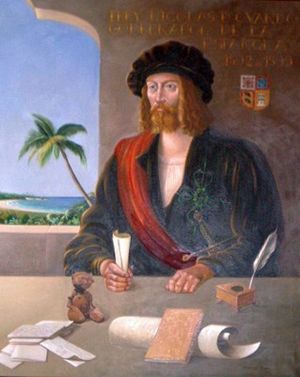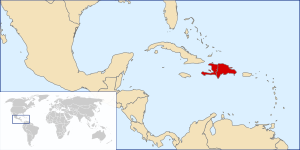Nicolás de Ovando facts for kids
Quick facts for kids
The Most Excellent
Nicolás de Ovando
|
|
|---|---|
 |
|
| 3rd Governor of the Indies | |
| In office 3 September 1501 – 1509 |
|
| Appointed by | Isabella I of Castile |
| Preceded by | Francisco de Bobadilla |
| Succeeded by | Diego Columbus |
| Personal details | |
| Born | 1460 Brozas, Extremadura, Spain |
| Died | 29 May 1511 (aged 50-51) Seville, Spain |
| Resting place | Church of San Benito de Alcántara |
Frey Nicolás de Ovando (born around 1460 – died May 29, 1511) was a Spanish soldier. He came from a noble family and was a Knight of the Order of Alcántara. This was a military order in Spain. He served as the Governor of the Indies (which was the island of Hispaniola) from 1502 to 1509. The Spanish rulers sent him to check on the previous governor, Francisco de Bobadilla. His job was to bring order back to the colony. During his time, he brought rebellious Spaniards under control. He also oversaw a period where the native Taíno population of Hispaniola greatly declined due to harsh conditions and conflicts.
Contents
Early Life and Military Service
Nicolás de Ovando was born around 1460 in a region of Spain called Extremadura. Some say he was born in Brozas. However, a historian named Gonzalo Fernández de Oviedo y Valdés, who knew him well, said he was from the city of Cáceres. His family was well-known. He was the second son of Captain Diego de Cáceres Ovando and Isabel Flores.
Ovando joined the military Order of Alcántara. He became a high-ranking leader, known as a Commander-Major. This Spanish military order was founded in 1156. It was similar to the Knights Templar. They fought against the Moors during a period known as the Reconquista. His older brother was Diego de Cáceres y Ovando.
Becoming Governor
As a Commander, Ovando became a favorite of the Spanish rulers, especially Queen Isabella I of Castile. Because of this, on September 3, 1501, Queen Isabella chose Ovando to replace Francisco de Bobadilla. This decision came after complaints from Christopher Columbus and others about Bobadilla's rule. Ovando became the third Governor of the Indies. This included the islands and the mainland areas.
Journey to the Americas
On February 13, 1502, Ovando sailed from Spain with a large fleet of thirty ships. This was the biggest fleet that had ever traveled to the New World at that time.
The thirty ships carried about 2,500 colonists. Unlike Christopher Columbus's earlier trips, these colonists were carefully chosen. They represented different parts of Spanish society. The Spanish Crown wanted to develop the West Indies economically. They also wanted to spread Spanish political, religious, and administrative influence there. Among those who came with him was Francisco Pizarro. Pizarro later explored South America and conquered the Inca Empire. Another person on a ship was Bartolomé de las Casas. He became known as the 'Protector of the Indians' because he spoke out against the harsh treatment of native people.
The expedition arrived in Santo Domingo in April 1502. Other notable people on board included Diego de Nicuesa and Lucas Vázquez de Ayllón. Also, 13 Franciscans (religious friars) came with the group. They were led by Friar Alonso de Espinar. This brought the total number of Franciscans on the island to 25.
His Time as Governor
When Ovando arrived in Hispaniola in 1502, he found the native people in revolt. Ovando and his officers put down this rebellion. They did this through a series of difficult campaigns, including events like the Jaragua Massacre and Higüey Massacre. Ovando’s rule in Hispaniola became known for its harshness toward the native Taíno people.
Historians estimate the Taíno population was around 500,000 people when the Spanish arrived in 1492. By a census in 1507, according to Bartolomé de las Casas, the native population had dropped to about 60,000 people. This decline was due to conflicts, forced labor, and diseases. In 1501, Ovando ordered the first group of people from Africa to be brought to the Americas to work. Many Spanish nobles had these workers in their homes.
After his officers, including Juan Ponce de León and Juan de Esquivel, made new conquests, Ovando founded several cities on Hispaniola. He also helped develop the mining industry. He brought sugar cane plants from the Canary Islands to be grown. He also sent out expeditions to explore and conquer other parts of the Caribbean. Ovando allowed Spanish settlers to use the native people for forced labor. This system was called encomienda. The native people had to provide food for the colonists and for ships going back to Spain. Many Taíno people died while being forced to dig for gold in the mines.
King Ferdinand II of Aragon called Ovando back to Spain in 1509. This was to address concerns about how he treated the native people. Diego Columbus was chosen to be the next governor. However, the Spanish Crown allowed Ovando to keep the property he brought back from the Americas.
Later Years
Not much is known about what Ovando did after he returned to Spain in 1509. He likely spent a lot of his time in Brozas. This town was the main center for the Order of Alcántara. In February 1511, King Ferdinand ordered Ovando to join him on a military trip to Oran, in North Africa. This trip never happened. However, Ovando was at a large meeting of his order in Seville in early May. Nicolás de Ovando died in Seville on May 29, 1511. His body was moved to the monastery of San Benito de Alcántara. In his will, he set up a chapel and asked the friars to say a special prayer service every week.
See also
 In Spanish: Nicolás de Ovando para niños
In Spanish: Nicolás de Ovando para niños
- Colony of Santo Domingo
- People of the Colony of Santo Domingo
- Spanish Empire
- Spanish West Indies
- Viceroyalty of New Spain


